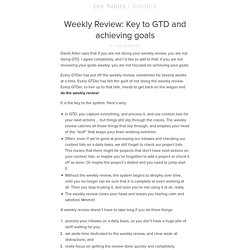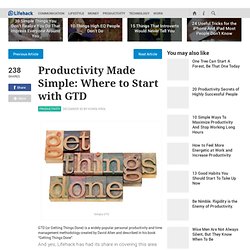

Getting started with "Getting Things Done". This article was originally posted during the first week of 43 Folders' existence, and, pound for pound, it remains our most popular page on the site.

Please be sure to also visit related pages, browse our GTD topic area, plus, of course you can search on GTD across our family of sites. I’ll be talking a lot here in coming weeks about Getting Things Done, a book by David Allen whose apt subtitle is “The Art of Stress-Free Productivity.” You’ve probably heard about it around the Global Interweb or have been buttonholed by somebody in your office who swears by GTD. (It probably takes a backseat only to the Atkins Diet in terms of the number of enthusiastic evangelists: sorry about that.)
Like I did the other day with Quicksilver, I wanted to provide a gentle, geek-centric introduction to Getting Things Done, so that you can think about whether it might be right for you. The Problem with “stuff” Stuff is bouncing around in our heads and causing untold stress and anxiety. GTD is geek-friendly. » Weekly Review: Key to GTD and achieving goals. By Leo Babauta David Allen says that if you are not doing your weekly review, you are not doing GTD.

I agree completely, and I’d like to add to that: if you are not reviewing your goals weekly, you are not focused on achieving your goals. Every GTDer has put off the weekly review, sometimes for several weeks at a time. Every GTDer has felt the guilt of not doing the weekly review. Every GTDer, to live up to that title, needs to get back on the wagon and do the weekly review! It is the key to the system. In GTD, you capture everything, and process it, and use context lists for your next-actions … but things still slip through the cracks. A weekly review doesn’t have to take long if you do three things: process your inboxes on a daily basis, so you don’t have a huge pile of stuff waiting for you; set aside time dedicated to the weekly review, and clear aside all distractions; andreally focus on getting the review done quickly and completely. Here are the basic steps to a weekly review:
Productivity Made Simple: The Key to GTD. Sounds serious, doesn’t it?

Thankfully, the whole idea turns out to be quite easy to grasp. But first… At this point you already know what the main elements of productivity are and where to start with GTD. This is all great, but we’re still lacking one important piece of information… What the hell to do with all this stuff?! And today, we’re going to cover exactly that. Understanding the Diagram of Action When working with GTD you’re basically doing one of three things at all times: Take care of defined tasks.Take care of undefined tasks.Plan (define) your tasks. These things fall into a loop, and repeat themselves throughout the day, week, month, and so on. Planning your tasks will be the topic of the next post in this series, so let’s leave it for now and focus on the first two things. Defined tasks/activities are everything that’s in your Projects List, Next Tasks List, Future/maybe List, and Calendar. So defined tasks we’ve got covered. Getting to Know Your Daily Graph of Activity Now what? Productivity Made Simple: Where to Start with GTD.
GTD (or Getting Things Done) is a widely popular personal productivity and time management methodology created by David Allen and described in his book “Getting Things Done”.

And yes, Lifehack has had its share in covering this area already. For instance, by doing a simple search on Google you can quickly find out that there are more than 6,000 pages on Lifehack that mention GTD in one way or the other. So the whole idea seems discussed enough, right? Perhaps…but it is definitely worth revisiting as we enter a new year. Consider that despite thousands of articles around the internet there is still one main problem with GTD – it’s not a methodology that’s easy to grasp. It has a learning curve and if you simply throw yourself in the middle of it you might get the wrong overall impression about the system and abandon it after just a short while. Productivity Made Simple: The 7 Main Elements of GTD.
Just like the five elements (Fire, Earth, Metal, Water and Wood), GTD has its own elements.

Only there are seven instead of five…and not nearly as epic. In the previous parts of this series we were talking about things like how to select what to do next, and how to compile your projects list (and your next tasks list). Today it’s time to get deeper into this topic, and explain the main elements a little more in detail. Not to keep you hanging any longer…let me tell you what the seven main elements of GTD are: Projects ListNext Tasks ListFuture/maybe ListCalendar“Waiting for” ListResource FilesThe Intangible One (wait for it…)